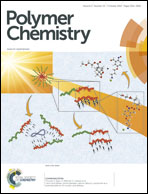In situ synthesis of thermo-responsive ABC triblock terpolymer nano-objects by seeded RAFT polymerization†
Abstract
RAFT polymerization of N-isopropylacrylamide under heterogeneous conditions in the presence of diblock copolymer nano-objects of polystyrene-block-poly(N,N-dimethylacrylamide) trithiocarbonate (PS-b-PDMA-TTC) with the Z-group RAFT terminal on the outer side of the solvophilic poly(N,N-dimethylacrylamide) (PDMA) block is performed. This heterogeneous RAFT polymerization, which is named seeded RAFT polymerization, affords the in situ synthesis of the polystyrene-block-poly(N,N-dimethylacrylamide)-block-poly(N-isopropylacrylamide) (PS-b-PDMA-b-PNIPAM) triblock terpolymer nano-objects. The molecular weight of the triblock terpolymer linearly increases with the monomer conversion during the seeded RAFT polymerization. The morphology of the PS-b-PDMA-b-PNIPAM triblock terpolymer nano-objects is merely duplicated from the seed of the PS-b-PDMA-TTC diblock copolymer, which is the binary mixture of nanospheres and nanorods, when the polymerization degree (DP) of the poly(N-isopropylacrylamide) (PNIPAM) block is low or moderately large. When the DP of the PNIPAM block is relatively large, the triblock terpolymer nanospheres are formed. The size of the PS-b-PDMA-b-PNIPAM triblock terpolymer nano-objects slightly increases initially and subsequently decreases with the monomer conversion during the seeded RAFT polymerization. In water at temperature above the phase-transition temperature (PTT) of the PNIPAM block, the PNIPAM chains deposit onto the polystyrene (PS) core to form the triblock terpolymer multicompartment nano-objects containing a microphase separated solvophobic core of PS/PNIPAM and a solvophilic PDMA corona. Our findings are anticipated to be useful in preparation of concentrated ABC triblock terpolymer nano-objects.


 Please wait while we load your content...
Please wait while we load your content...